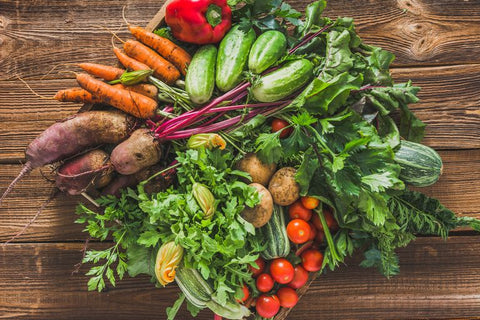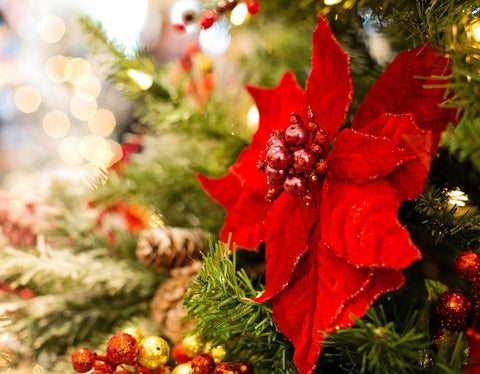Winter can be tough, and not just because of the weather. Depending on where you live, you might be dealing with limp lettuces, tasteless tomatoes, and <gasps!!> maybe even dried herbs.
It doesn’t have to be this way though. There’s light at the end of this tunnel, and if you’ve got some on your windowsill then why not make use of it to grow some hardy winter herb varieties that pair well with winter cooking? Here’s the d-low on some of our fave winter-hardy herbs to grow indoors so you can start your own indoor winter herb garden now.
What Herbs Can Be Grown Indoors in Winter?
Rosemary
This herb, which is one of the best indoor herbs to grow during winter, has a woody stem and thick leaves that stand up well year-round. In addition to being able to tolerate winter’s cooler temperatures, rosemary also pairs well with hearty root vegetables, roasts, and warming flavors like garlic.
Rosemary has long been hailed for its medicinal properties. Rosemary was traditionally used to help alleviate muscle pain, improve memory, boost the immune and circulatory systems, and promote hair growth.
Growing Tip: Rosemary prefers drier conditions – so we recommend you use soil for this one and not a bottle garden.
Rosemary seeds also happen to be very expensive! They cost 10-20x more than most of the other seeds we offer, which is often why you’ll notice that most large multi or variety packs of seeds leave it out.

Thyme
In the kitchen, thyme is most commonly used for soups and sauces. With its slightly citrus flavor, it does a great job of breaking up starch-heavy foods like potato, rice, and even fresh bread. It also goes well with most root vegetables and roasts.
Thyme is believed to lower blood pressure, stop coughing and boost immunity.
Growing Tip: The variety of Thyme we offer is actually a Summer one. Although it’s a bit less cold-resistant than German Winter Thyme, it makes up for it with a zestier and more pungent flavor.
Parsley
Parsley has two main types, flat-leaves and curly. Of the two, flat-leaf has the more robust flavor, and curly is considered more decorative – though both look great as a garnish. We also offer French Parsley (also known as Chervil) in our Culinary Classics Bottle Garden Kit. Having tested all of them in our bottle gardens, we found that this one performed the best.
Parsley pairs well with pasta, pizza, some salads, and a lot of cooked breakfast foods.
Cooking Tip: Whenever you’re using leafy herbs like parsley, basil, and cilantro in cooking you want to avoid subjecting them to too much heat. Personally, I try to add them either after plating as a garnish (so no heat at all) or at the earliest, I’ll add them in the last 30 seconds of cooking if I want to soften them a little or mix them through.

Chives
Chives are a cold-tolerant perennial herb, and among the best herbs to grow inside in winter/early spring as they do like full sun. It likes fertile, rich, well-draining soil, and if left to flower will spread quickly. Chives are related to onions and leeks, and you’ll notice this association in their taste.
They offer a much milder flavor than their relatives, and while onions and leeks should be subjected to heat in cooking, we generally recommend you do not subject chives to too much heat as this will make their subtle flavor almost undetectable.
Chives are popular in French cuisine where they are one of the ‘fines herbes’, which is a term for the core set of herbs used throughout French cooking.
Oregano
Some might call it “the pizza herb” – and although it does have a much wider range of uses, this herb does have one of the boldest and most distinctive flavor profiles of all the herbs we’ve listed here. It will overpower light delicate dishes and is better suited to pairing with more wholesome meals. A little oregano goes a long way!
Its most common culinary pairings are grilled, fried, or roasted vegetables as well as meats and fish. Unlike leafy green herbs (as mentioned above) oregano is one that you can afford to subject to some heat in cooking – doing so will release some of its essential oils and soften the flavor though, so don’t go overboard.
Growing Tips: like the other Mediterranean herbs on this list, oregano is sensitive to overwatering. It’s another one that is unlikely to do well in our bottle gardens, and instead, we recommend free-draining soil for this one.

All herbs, regardless of when or where you grow them, need light. Our video shows you how to set up a DIY grow light for less than $40, so that’s a pretty easy fix.
We have also created individual blogs about how you can grow different kinds of herbs, vegetables, and fruits. Check out how to grow rosemary, thyme, parsley, chives, and oregano here.









There are no comments for this article. Be the first one to leave a message!